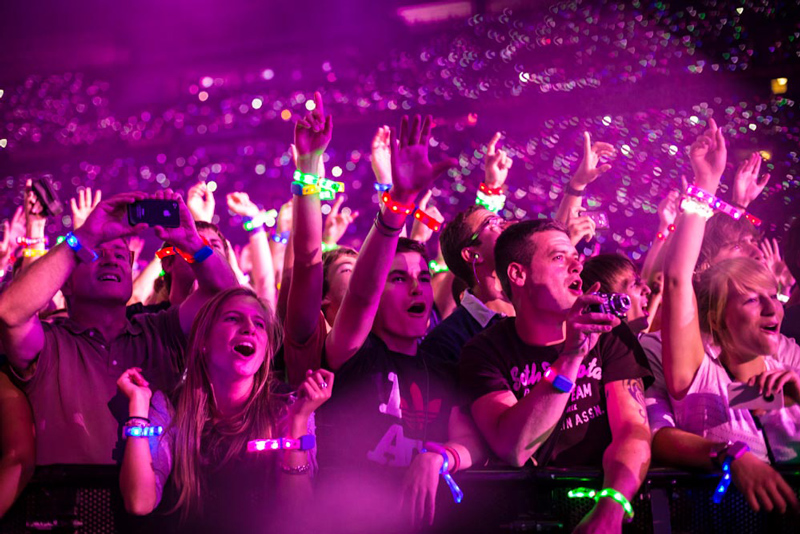Coldplay Concerts Look Stunning Thanks To These Light-Up Wristbands. How Do They Work?
Coldplay always puts on incredible shows, and that's largely thanks to the thousands of light-up wristbands worn by the crowd.
If you paid any attention at all to the recent Coldplay concert that took place at the Bukit Jalil National Stadium on 22 November, you'd have probably seen of how dazzling the entire stadium looked throughout the show
If you were in the crowd, you'll probably remember how the band on your wrist managed to flash, pulse, and glow in all sorts of different colours as the night progressed, conjuring different lighting effects and moods to suit each song in the setlist.
For many, these bands might really seem like technological marvels, transforming the audience from passive spectators into active participants while creating a sense of unity and shared emotion that goes beyond the music itself.
But here's the thing that might surprise you: Despite appearing quite novel, the concept behind these light-up bands has been around for way longer than you think
For context, synchronised lighting was already a thing when acts like Pink Floyd and The Who were in their prime.
However, in 2002, Coldplay took the idea to the next level when the band decided to partner with British tech firm RB Concepts to develop one of the earliest versions of its concerts'light-up wristbands, then known as the Xyloband (named after the Xylo Myloto Tour).
These bands were used extensively throughout the 2012 tour in shows around the globe, captivating concert-goers with remarkable synchronised light shows.
Though it may seem complicated, the principle behind how Xylobands work is pretty straightforward
Alongside other similar band technologies (such as PixMob or the ones used in some K-Pop concerts' lightsticks), Xylobands employ a wireless transfer technology, usually radio frequency (RF) or infrared (IR), to communicate with a series of transmitters strategically laid around each concert venue.
Here's how they operate:
1. Signal Transmission: The central control system, typically operated by the lighting technician or stage manager, transmits RF/IR signals to a network of transmitters strategically placed throughout the stadium. These transmitters act as relays, receiving and redistributing the signals to the wristbands worn by the audience.
2. Reception and Processing: Each wristband contains a tiny microcontroller that receives and interprets the signals from the transmitters. The microcontroller decodes the signals, determining the desired colour and timing for the wristband's LED lights.
3. Colour Activation: The microcontroller sends instructions to the wristband's LED lights, activating the corresponding colour based on the received signal. The LED lights are precisely timed to match the rhythm and mood of the music, creating synchronised patterns and effects.
4. Synchronisation with Music: The central control system ensures synchronisation between the music and the wristband lights by sending IR codes that correspond to the tempo, beat, and dynamics of the songs. This synchronisation allows the wristbands to create a dynamic light show that complements and enhances the musical performance.
5. Additional Features: Some advanced wristbands, like PixMob's, offer additional features beyond simple colour changes. These may include:
- Video Display: The wristbands can display short video clips or animations, transforming the audience into a giant screen.
- Motion Sensitivity: The lights can respond to the wearer's movements, creating dynamic patterns that react to the energy of the crowd.
- Audience Interaction: The wristbands can even be controlled by the wearer, such as clapping or cheering, allowing the audience to actively participate in the light show.
When smartly manipulated, these effects all end up transforming passive spectators into active participants of the concert, who glow, flash, and vibe with each tempo switch or change in the melody
More than anything, the recent Coldplay concert at the Bukit Jalil National Stadium was a testament to the transformative power of light-up wristbands.
As the band played their iconic hits, the stadium transformed into a sea of pulsating lights (almost literally a "sky full of stars"), creating a mesmerising visual accompaniment to the music.
While light-up wristbands have clearly revolutionised the concert experience, future innovations might take their use beyond what we currently enjoy.
Imagine entire sections of a venue equipped with RF-controlled displays or new types of wearables that attendees can use to create much more complex light shows than ever before.
